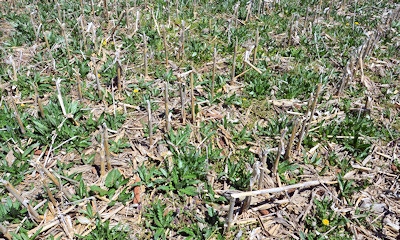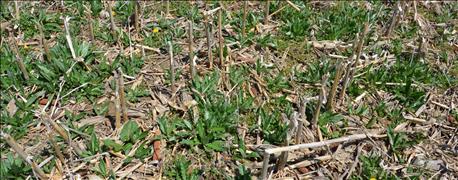
Bill Johnson couldn’t go to the field, so we took the field to him - virtually, that is. He examined photos and outlined what he would do in terms of weed control if it was his field.
In this case, the first picture he saw was a close-up shot of young Canada thistles, with numerous dandelions thrown in, and a few winter annuals. The field was in corn stalks, waiting for no-till soybeans.
Johnson is the Purdue University Extension weed control specialist. So what would he recommend?

ONE TOUGH FIELD: With thistles and dandelions as the main weed culprits, weed expert Bill Johnson has a very specific crop recommendation. Check out the field comparison slider below to see two weed options.
“If Canada thistles and dandelions are that prevalent, or even close to that prevalent, in the entire field, my first recommendation would be changing crops,” he says. “Come back with corn and work on these weeds. You have a lot more tools to work on them with in corn than in soybeans.”
Johnsons says in a badly infested field with Canada thistles and dandelions, he wouldn’t hesitate to go to corn, and to apply Stinger, a very good herbicide on these weeds.
If you don’t have a choice but to go to soybeans, then he would hit the field hard with a burndown of glyphosate and 2-4,D. “I would likely go with a rate of 2,4-D which will mean waiting a significant interval before coming back and planting soybeans,” he says.
Paying attention to the wait period before planting soybeans after 2,4-D is crucial, he says. Check labels for actual restriction in days from application to planting. It depends on the rate of 2,4-D applied. It would take a healthy rate of 2,4-D to work on these weeds, he says.
A different weed infestation
Suppose the field looks more like the second image where chickweed is the most obvious weed, although you can see one or more patches of thistles and scattered dandelions in the field. Johnson said it would at least be more feasible to no-till soybeans into that situation than into a field choked with Canada thistle and dandelion.
Classic with glyphosate plus 2,4-D might be a prudent burndown in a field where thistles and dandelions are only scattered, he notes. If you used 2,4-D, you might be able to use a lower rate, which wouldn’t require so much time between application and planting.
For residual control in soybeans based on typical weeds in east-central Indiana, where this field is located, Johnson would suggest a Valor or Authority product as the base. They would provide good activity on pigweed and other small –seeded broadleaves.
Using a new tool below we show you the two fields we showed Bill Johnson - you can slide to compare the weed pressures in each.
About the Author(s)
You May Also Like




